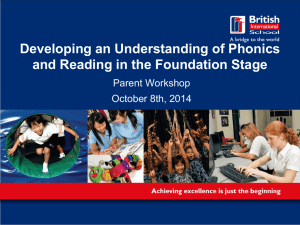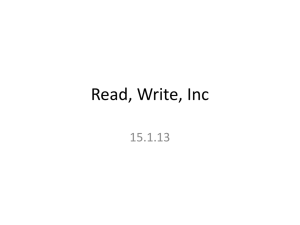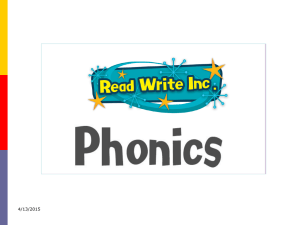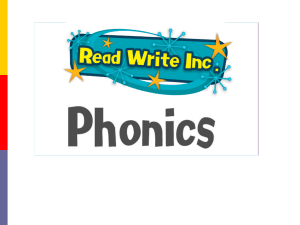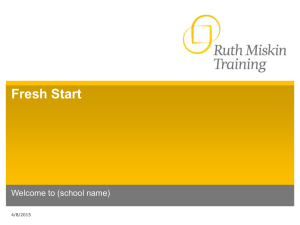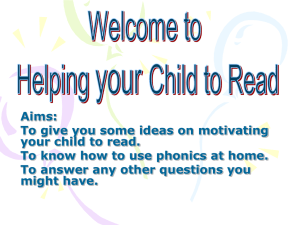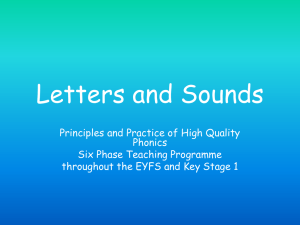Learn to read - Bowes Hutchinson`s C of E (Aided)
advertisement
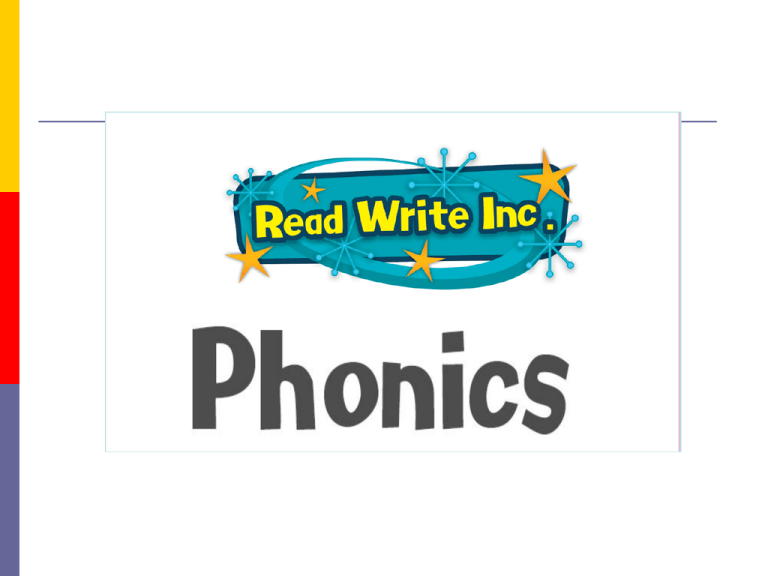
Welcome Why Read, Write, Inc? Why synthetic phonics? As a school we were wanting to continue to raise reading standards and felt we needed a programme that would bring consistency throughout the school. The programme is a specialised programme which is extremely prescriptive and it encompasses all abilities All school staff have undertaken the training and the programme is running throughout KS1 and into KS2 as a catch up programme. Why synthetic phonics? “Synthetic phonics offers the vast majority of young children the best and most direct route to becoming skilled readers and writers” Sir Jim Rose Rose Review of Reading 2006 Synthetic phonics is simply the ability to convert a letter or letter group into sounds that are then blended together into a word. Why Read Write Inc Phonics? We chose this particular programme because It is rooted in synthetic phonics. It has been tried and tested. It is systematic, structured and therefore results in rapid teaching and learning of sounds and blending. The children are reading books that are carefully matched to the sounds they know. Which means that children are successful from the very beginning! Ruth Miskin “When children can’t read there is low self esteem. We want them to be reading with confidence, to be able to read quite sophisticated texts at an early age.” Ruth Miskin – former headteacher and creator of Read Write Inc Phonics A rapid Learn to read programme so that children can… Read to learn for the rest of their lives Who is it for? Children from 4 years who are starting school – Read Write Inc is a ‘start-up’ reading programme Older children who have found reading difficult Read Write Inc is a ‘catch-up’ programme How does it work? Decoding Your child will: Learn 44 sounds and corresponding letters and letter groups Learn how to read words by blending Read lots of specially written books featuring all the words they have learned to sound out and blend This is known as decoding How does it work? Comprehending Your child will: Talk a lot about what they have read to show their own understanding Listen to and discuss other ideas to deepen understanding This is known as comprehending Sounds All words are made up of sounds In English there are 44 “so i_f I t_al_k i_n th_i_s w_ay, you w_ill h_ear ea_ch s_ou_n_d . We use pure sounds (‘m’ not’ muh’, ’s’ not ‘suh’, etc.) so that your child will be able to blend the sounds into words more easily. ***New sound time*** About Fred... We use Fred to help the children to learn to read Fred can only talk in sounds... (Fred can only say c_a_t, he can’t say cat) We call this Fred Talk More about Fred... If pupils can understand what Fred says they can blend orally Blending is needed for reading Green cards Copyright Ruth Miskin Literacy Graphemes A grapheme is a sound written down In English there are more than 150 graphemes which means it is a very complex code Chart We use a chart showing the most usual ways the 44 sounds can be written down Learning the code We start off teaching your child a simple version of the code The complex English alphabetic code There ar graphemes in a word i-n contains 2 sounds and 2 graphemes c-a-t ch-a-t l-igh-t c-r-a-sh As they learn the sounds and graphemes, we will teach your child to blend by hearing the words in Fred Talk 1st. Once they know the graphemes they can sound-blend/Fred Talk to read words. Consonants: stretchy f l m n r s v z sh th ng nk Consonants: bouncy b c k d g h j p qu t Vowels: bouncy a e oo oo w x y ch igh ow Vowels: stretchy i o ar Set 1 sounds u or ay air ee ir ou oy Set 2 sounds f l m n r s v z sh ff ph ll le mm mb nn kn rr wr ss se c ce ve zz s ti ci b c k d g bb ck ch dd gg a e h i j p g ge dge pp o u ea oo u_e ue ew oo ar qu t w tt wh th x ng nk y ch tch ay ee igh ow a_e ai y ea e i_e ie i o_e oa o or air ir ou oy oor ore aw au are ur er ow oi ire ear ure Even more about Fred... We use Fred to help the children to learn to spell as well! Children convert a whole word they hear into sounds They put sounds they hear in a word on their fingers... We call this Fred Fingers Storybooks and Get Writing Books Every day, your child will read and write the words that contain the sounds and graphemes they have learned so far, using lively, fun phonic storybooks and a Get Writing book. So how can you help your child? By knowing the 44 sounds And helping your child to learn them By knowing how to blend using Fred Talk for reading m_a_t By knowing how to do Fred Fingers for spelling So how can you help your child? By using Fred Talk sometimes at home with everyday words like these: back, head, tum, leg, hand, foot, knee coat, hat, scarf, zip, sock, glove run, walk, skip, hop, fast, slow, stop, shop red, blue, green, black, knife, fork, spoon, plate, bowl, pan bread, cheese, meat, soup, jam, cake So how can you help your child? By reading to your child lots of lovely stories that are at a higher level than your child can read and asking lots of questions! What is happening in this part of the story? What do you think happens next? What do you think that character is feeling now? What is that character thinking What is that character saying? And... By talking to your child as much as possible and ‘feeding’ them new and different words. The more words your child has in his/her head when they come to school each day, the quicker their understanding (comprehension) when they learn to read (decode) those words. “Let’s eat our lunch now.” “Let’s munch our lunch now.” “Let’s devour our lunch now.” “Wow that’s a big slide!” “Wow that’s an enormous slide!” “Wow that’s a massive slide!” So how can you help your child? By enriching conversations through description: “Look at that rain. It looks like little diamonds hitting the window pane!” By having fun with words and language. “I’m as hot as a spud in a cooking pot!” By praising your child for using new words or interesting images So how can you help your child? By having a look at the Read Write Inc At Home pages on the web for tips and resources for supporting our child at home: www.ruthmiskinliteracy.com or www.oup.com (RWI resources are published by Oxford University Press)
